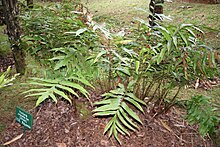Family of ferns
| Tectariaceae |
 |
| Tectaria crenata |
Scientific classification  |
| Kingdom: | Plantae |
| Clade: | Tracheophytes |
| Division: | Polypodiophyta |
| Class: | Polypodiopsida |
| Order: | Polypodiales |
| Suborder: | Polypodiineae |
| Family: | Tectariaceae
Panigrahi |
| Genera |
| See text. |
| Synonyms[citation needed] |
- Aspidiaceae Baker, nom. ill.
- Arthropteridaceae Liu, Hovenkamp & Schneider
- Dictyoxiphiaceae Ching, nom. inv.
- Hypoderriaceae Ching, nom. inv.
|
Tectariaceae is a family of leptosporangiate ferns in the order Polypodiales. In the Pteridophyte Phylogeny Group classification of 2016 (PPG I), the family is placed in the suborder Polypodiineae.[1] Alternatively, it may be treated as the subfamily Tectarioideae of a very broadly defined family Polypodiaceae sensu lato.[2] The family comprises seven genera, of which Tectaria is by far the largest.[1]
Taxonomy
In 1990, Karl U. Kramer and coauthors treated Pleocnemia and 7 of the currently recognized genera as a subfamily of Dryopteridaceae.[3] Two other genera, Arthropteris and Psammiosorus, along with Oleandra, constituted Kramer's Oleandraceae. It is now known that Kramer's version of Dryopteridaceae is polyphyletic. Arthropteris (including Psammiosorus) lies within Tectariaceae and Tectariaceae is sister to a clade consisting of Oleandraceae, Davalliaceae, and Polypodiaceae.[4] In 2006, in a revision of fern classification, Tectariaceae was an accepted family.[5] In 2007, a molecular phylogenetic study of Dryopteridaceae included Pleocnemia and showed that it belongs in Dryopteridaceae.[6] Also in 2007, Dracoglossum was named as a new genus.[7] It has since been removed to Lomariopsidaceae.
Phylogeny
In 2016, a cladistic analysis of Tectariaceae separated two new genera, Draconopteris and Malaifilix, from Tectaria sensu stricto.[8]
Genera
As of November 2019[update], the Checklist of Ferns and Lycophytes of the World accepted the following genera. Polydictyum was separated from Tectaria after the publication of PPG I in 2016.[11]
References
- ^ a b c PPG I (2016), "A community-derived classification for extant lycophytes and ferns", Journal of Systematics and Evolution, 54 (6): 563–603, doi:10.1111/jse.12229, S2CID 39980610
- ^ Christenhusz, Maarten J.M. & Chase, Mark W. (2014). "Trends and concepts in fern classification". Annals of Botany. 113 (9): 571–594. doi:10.1093/aob/mct299. PMC 3936591. PMID 24532607.
- ^ Karl U. Kramer (with Richard E. Holttum, Robin C. Moran, and Alan R. Smith). 1990. "Dryopteridaceae". pages ??. In: Klaus Kubitzki (general editor); Karl U. Kramer and Peter S. Green (volume editors) The Families and Genera of Vascular Plants volume I. Springer-Verlag: Berlin;Heidelberg, Germany. ISBN 978-0-387-51794-0
- ^ Eric Schuettpelz and Kathleen M. Pryer. 2007. "Fern phylogeny inferred from 400 leptosporangiate species and three plastid genes" Taxon 56(4):1037–1050. doi:10.2307/25065903 (See External links below).
- ^ Alan R. Smith, Kathleen M. Pryer, Eric Schuettpelz, Petra Korall, Harald Schneider, and Paul G. Wolf. 2006. "A classification for extant ferns." Taxon 55(3):705-731. doi:10.2307/25065646 (See External links below).
- ^ Hong-Mei Liu, Xian-Chun Zhang, Wei Wang, Yin-Long Qiu, and Zhi-Duan Chen. 2007. "Molecular Phylogeny of the Fern Family Dryopteridaceae inferred from Chloroplast rbcL and atpB genes". International Journal of Plant Sciences 168(9):1311-1323. doi:10.1086/521710
- ^ Maarten J.M. Christenhusz. 2007. "Dracoglossum, a new Neotropical fern genus (Pteridophyta)". Thaiszia Journal of Botany 17:1-10.
- ^ a b Liang Zhang, Eric Schuettpelz, Carl J. Rothfels, Xin-Mao Zhou, Xin-Fen Gao, and Li-Bing Zhang. 2016. "Circumscription and phylogeny of the fern family Tectariaceae based on plastid and nuclear markers, with the description of two new genera: Draconopteris and Malaifilix (Tectariaceae)". Taxon 65(4):723–738. doi:10.12705/654.3
- ^ Nitta, Joel H.; Schuettpelz, Eric; Ramírez-Barahona, Santiago; Iwasaki, Wataru; et al. (2022). "An Open and Continuously Updated Fern Tree of Life". Frontiers in Plant Science. 13: 909768. doi:10.3389/fpls.2022.909768. PMC 9449725. PMID 36092417.
- ^ "Tree viewer: interactive visualization of FTOL". FTOL v1.3.0. 2022. Retrieved 12 December 2022.
- ^ Hassler, Michael & Schmitt, Bernd (November 2019). "Tectariaceae". Checklist of Ferns and Lycophytes of the World. 8.11. Retrieved 2019-11-28.
External links
- 400 leptosporangiates
- A classification for extant ferns
- Domain
- Archaea
- Bacteria
- Eukaryota
- (major groups
- Excavata
- Diaphoretickes
- Hacrobia
- Rhizaria
- Alveolata
- Stramenopiles
- Plants
- Amorphea
- Amoebozoa
- Opisthokonta
- Animals
- Fungi)
|
|
|
|
|
|---|
- Supergroup Plant:
- Bryophyta
- Marchantiophyta
- Polypodiophyta
- Acrogymnospermae
- Angiospermae
|
| Basal clade | |
|---|
| †Cladoxylopsida | |
|---|
| Polypodiopsida | | †Stauropterididae | |
|---|
| †Zygopterididae | |
|---|
| Equisetidae | | | Equisetales | - †Asterocalamitaceae
- †Autophyllitaceae
- †Honseleriaceae
- †Archaeocalamitaceae
- †Paracalamitaceae
- †Calamitaceae
- †Apocalamitaceae
- †Konnostachyaceae
- †Manchurostachyaceae
- †Notocalamitaceae
- †Schizoneuraceae
- †Sorocaulinaceae
- †Echinostachyaceae
- †Gondwanostachyaceae
- †Tchernoviaceae
- Equisetaceae
|
|---|
|
|---|
| Ophioglossidae | |
|---|
| Marattiidae | | Marattiales | - †Knorripteridaceae
- †Pecopteridaceae
- †Ptychocarpaceae
- †Weichseliaceae
- †Asterothecaceae
- †Danaeopsidaceae
- Marattiaceae
|
|---|
|
|---|
| Polypodiidae | |
|---|
|
|---|
|
Taxon identifiers |
|---|
| Tectariaceae | |
|---|














